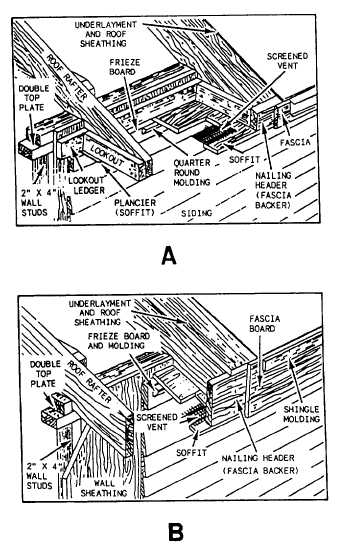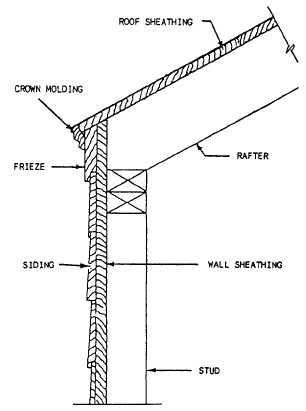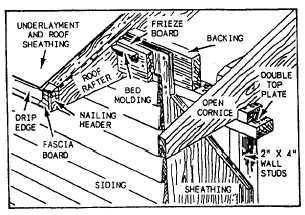Figure 3-8.-Simple cornice.
Figure 3-9.-Open cornice.
CORNICES
The type of cornice required for a particular
structure is indicated on the wall sections of the
drawings, and there are usually cornice detail drawings
as well. A roof with no rafter overhang or cave usually
has the simple cornice shown in figure 3-8. This cornice
consists of a single strip or board called a frieze. It is
beveled on the upper edge to fit under the overhang or
cave and rabbeted on the lower edge to overlap the upper
edge of the top course of siding. If trim is used, it usually
consists of molding placed as shown in figure 3-8.
Molding trim in this position is called crown molding.
Figure 3-10.-Closed cornices: A. Flat boxed cornice; B. Sloped
boxed cornice.
A roof with a rafter overhang may have an open
cornice or a closed (also called a box) cornice. In
open-cornice construction (fig. 3-9), the undersides of
the rafters and roof sheathing are exposed. A nailing
header (fascia backer) is nailed to the tail ends of the
rafters to provide a straight and solid nailing base for the
fascia board. Most spaces between the rafters are
blocked off. Some spaces are left open (and screened)
to allow attic ventilation. Usually, a frieze board is nailed
to the wall below the rafters. Sometimes the frieze board
is notched between the rafters and molding is nailed over
it. Molding trim in this position is called bed molding.
In closed-cornice construction, the bottom of the roof
overhang is closed off. The two most common types of
closed cornices are the flat boxed cornice and the sloped
boxed cornice (shown in figure 3-10, views A and B,
respectively).
3-9






